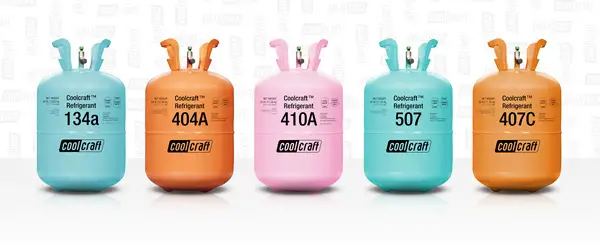Superheat charging in refrigeration might sound intimidating, but it’s a vital concept you need to grasp. When done right, it ensures your cooling system runs efficiently, saving you energy, money, and potential headaches. So let’s dive into this easy guide to help you master the art of superheat charging.

Table of Contents
What is Superheat Charging?
For the geeks…
Superheat charging is a method of adjusting the refrigerant charge in a refrigeration system to achieve a specific amount of superheat, ensuring the system operates efficiently. Superheat is the number of degrees a refrigerant vapor is above its saturation temperature at a particular pressure.
This method is commonly used in systems with thermostatic or electronic expansion valves and involves measuring and comparing the actual superheat to the target superheat, then adding or removing refrigerant accordingly.
For the rest of us…
Imagine you’re fine-tuning your AC or fridge, making it work like a charm. Superheat is how hot the refrigerant vapor gets above its boiling point. The goal? Hit that sweet spot for your system’s efficiency.
Picture your refrigeration system like a finely tuned orchestra. The thermostatic or electronic expansion valves are the conductors, and the refrigerant, the musicians. You’re the composer, adding or taking away notes (refrigerant) to create the perfect harmony (target superheat).
Ask yourself: Is the superheat too high? Time to add refrigerant, like sprinkling in more spices to your favorite dish. Too low? Remove some refrigerant, just like taking a step back to admire your masterpiece. You’re the artist, and your refrigeration system is your canvas.
Feel the rhythm of your system, listen to its hum, and watch it come alive as you balance the superheat just right. And when you nail that perfect harmony, you’ll know you’ve achieved refrigeration bliss.
Superheat Charging Video…
If you want to see a practical demonstration of superheat charging in a real life situation, watch the video below…
Tools and Equipment Needed for Superheat Charging
Before you get started, make sure you have these essential tools:
- HVAC gauges: To measure refrigerant pressure
- Temperature probes: For accurate temperature readings
- HVAC thermometer: To monitor ambient temperatures
- Refrigerant scale: To weigh the refrigerant
- Refrigerant recovery machine (optional): For safe refrigerant handling
- Personal protective equipment (PPE): Safety first!
Preparation for Superheat Charging
Safety Precautions
Before we dive in, let’s cover some safety basics. First, ensure proper ventilation in your workspace. Next, handle refrigerants with care—they can be hazardous. And don’t forget to wear your PPE, like gloves and goggles. Safety is always a top priority!
Ensuring System Readiness
Before charging your system, power it off and check for leaks. You’ll also need to identify the type of refrigerant you’re working with. Got that sorted? Great! Time to set up your tools.
Setting Up Tools and Equipment
Connect your HVAC gauges to the service valves, attach temperature probes to the suction line, and position the refrigerant scale nearby. Now you’re ready to rock and roll!
Superheat Charging Process
Calculating Target Superheat
To find your target superheat, you’ll need to measure the wet-bulb temperature indoors and the outdoor temperature. Then, use a superheat chart or formula to get your magic number. Simple enough, right?
Measuring Existing Superheat
Next, obtain the suction line temperature and read the suction pressure using your HVAC gauges. Convert this pressure to saturation temperature and then calculate your current superheat. Is it a match with your target? If not, let’s charge that system!
Charging the Refrigeration System
Establishing proper superheat means adding refrigerant to your system. As you do, keep an eye on the superheat levels. You want them to match your target, so be patient and make adjustments as needed. Almost there!
Verifying System Performance
Re-checking Superheat Levels
Once you’ve reached your target superheat, it’s time to evaluate the system’s performance. Is everything running smoothly? If so, give yourself a pat on the back!
Inspecting System Components
Now, let’s check for proper airflow and evaluate the temperature drop across the evaporator. Also, ensure the expansion device is working correctly. Everything looking good? Perfect!
Monitoring System Operation
Keep an eye on your system’s performance and watch for signs of incorrect superheat. Staying vigilant helps prevent future issues and keeps your system in tip-top shape.
Learn more on superheat charging and more…
Troubleshooting and Maintenance
Common Superheat-Related Issues
Insufficient or excessive superheat can cause problems, so let’s explore some potential solutions:
- Insufficient superheat: Check for low refrigerant levels, clogged filters, or a malfunctioning expansion device.
- Excessive superheat: Look for refrigerant leaks, restricted airflow, or issues with the expansion device.
Remember, a little troubleshooting goes a long way!
Regular System Maintenance
Keep your system in top condition by cleaning and inspecting components, ensuring proper refrigerant levels, and checking for leaks. A well-maintained system is a happy system!
When to Seek Professional Assistance
Don’t be afraid to call in the pros if you’re facing persistent superheat issues, complex system problems, or safety concerns. They’re there to help!